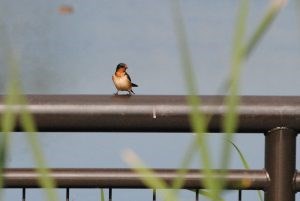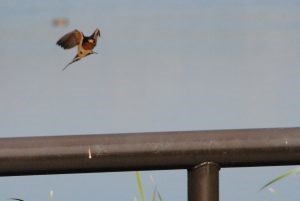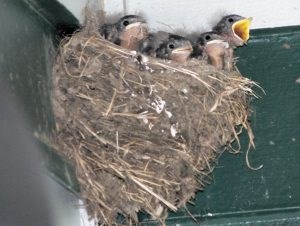This content was originally published by the Longmont Observer and is licensed under a Creative Commons license.
I’ve always admired the graceful way barn swallows skim over the ground or water in search of insects. As a girl, they amused me by swooping down on unsuspecting barn cats that had dared come too close to a nest. Recently, I spotted barn swallows out at the Jim Hamm Nature Area, and after several hours of trying, managed to capture a few photos of these beautiful birds.

Barn swallows are beautifully colored with a steel blue back, wings and tail, and rusty colored chest and belly. Their crown and face is blue while the forehead and throat are cinnamon colored. As with many bird species, the males are more brightly colored than the females. Barn swallows have a liquid, chattering sort of song that may end with a chirp. Alarm calls are a chideep. One thing that sets the barn swallow apart from other swallows is the deeply forked tail that extends beyond the wingtips.
There is a legend associated with the forked tale. According to this legend, the barn swallow stole fire from the gods to bring to the people. As it flew away, an angry god threw a burning stick at the barn swallow, burning away it’s middle tail feathers.
Barn swallows are highly adaptable birds, and can be found in most areas where people occur. They are found throughout North America up to 10,000 feet in elevation. Although they summer in North America, they usually spend their winters in Central and South America. Southern migration from the eastern coast states may begin as early as June and July. Barn swallows have been known to return to California as early as January.
Insects make up the barn swallow's diet, with the majority consisting of flies of all different types. Barn swallows also prey on other flying insects such as butterflies, moths, bees, wasps, and ants. Although they do not feed at backyard bird feeders, barn swallows may pick up crushed eggshells or oyster shells left out by humans as well as small pebbles for grit. This helps them digest insects and adds calcium to their diet. Barn swallows eat most often while flying and will even drink while in midair by dipping down to get a mouthful of water.
Barn swallows used to nest in caves, but now they nest almost exclusively on manmade structures near sources of mud. The only known population of barn swallows that still nests in caves is off the coast of California.
Both sexes participate in building the nest. Mud is mixed with grass stems to make pellets, which are then used to build the nest. A shelf is constructed first that allows the barn swallow to sit on it while it builds up the sides of its nest. The resulting nest will be a half-cup shape if it is placed against a vertical surface. In contrast, if the nest is built on top of a beam, the nest will form a complete cup that measures about three inches across and two inches deep.
Mud nests are lined with grass and feathers. It is not unusual for barn swallows to steal nesting materials from the neighboring nests of other barn swallows, especially when they live in colonies. Barn swallows may even sometimes reuse old nests as long as they are not infested with mites or other insects. Barn swallows prefer to place their nests under the eaves of buildings, on rafters and cross beams of barns, or on the underside of bridges and culverts.

Breeding occurs between May and August, depending on the location. New pairs usually form each breeding season, but a successful pair may continue to mate with each other in successive seasons. Barn swallows lay 3-7 eggs. These are incubated by both parents, although the female incubates the eggs more than the male. Eggs typically hatch in 13-17 days, and both parents feed the young. Sometimes, young from a previous brood will also help watch the nest and feed the young. Young leave the nest 18-23 days after hatching. Barn swallows have one or two broods per year. Unmated males may sometimes kill the nestlings of a pair, disrupting the pair bond and increasing the chance that unmated males can mate.
In the past, barn swallows were hunted for the hat trade, leading to a decline in population. This population decline prompted the naturalist George Bird Grinnell to write an essay in Forest and Stream about the senseless waste of bird life. This essay eventually led to the founding of the first Audubon Society.
Barn swallows are one of the focal species of a citizen-led science project called Celebrate Urban Birds by the Cornell Lab of Ornithology. This project allows ordinary citizens to learn about various birds and to contribute their observations. More information can be found at Cornell’s website. Look for these birds in intersections during light changes, open spaces, and over water. You are sure to be delighted by their agile flying and beautiful colors.


